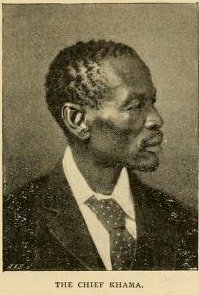Khama III
| Khama III | |||||
|---|---|---|---|---|---|
| King (Kgosi) of Bechuanaland, Ruler of the Bangwato people of central Botswana; Paramount Chief of the bamaNgwato | |||||
 |
|||||
| Reign | 1872–1873, 1875–1923 | ||||
| Successor | Sekgoma Khama, Kgosi Sekgoma II (1923–1925) | ||||
| Born | ca. 1837 Mashu, Bechuanaland |
||||
| Died | Feb 21, 1923 Serowe |
||||
| Wives | |||||
| Issue | 2 sons and 9 daughters by 4 wives: Bessie Khama, 1867-1920, married Chief Ratshosa (descendant of Chief Molwa) Sekgoma Khama(1869–1925) (Sekgoma II) Bonyerile Khama, b. 1901 Kgosi Tshekedi Khama (1905–1959) |
||||
|
|||||
| Father | Kgosikgolo Sekgoma, Kgosi Sekgoma I (1815–1883) | ||||
| Mother | Keamogetse | ||||
| Full name | |
|---|---|
| Khama III Boiklanyo |
Khama III (1837?–1923), referred to by missionaries as Khama the Good, was the kgosi (meaning chief or king) of the Bamangwato people of Bechuanaland (now Botswana), who made his country a protectorate of Great Britain to ensure its survival against Boer and Ndebele encroachments. One successful goal was to stop the westward expansion of the Transvaal. He fought on the British side in the 1893 Matable War. He gained some disputed territory as a result. When Cecil Rhodes threatened to expand north, he along with his chiefs and Protestant missionaries visited London. He was treated as a hero by evangelicals, and was received by Queen Victoria. He was guaranteed further protection. During the Anglo-Boer war of 1899-1902, he guarded British communication lines. He blocked incorporation into the white-run Union of South Africa in 1910. He built a well-organized, well-funded government with a bureaucracy dominated by Christian converts.
During the 18th century, Malope, chief of the Bakwena tribe, led his people from the Transvaal region of South Africa into the southeast territory of Botswana. Malope had three sons – Kwena, Ngwato, and Ngwaketse – each of whom would eventually break away from their father (as well as from each other) and form new tribes in neighboring territories. This type of familial break between father and sons (and then between sons) was historically how tribes proliferated throughout the southern African region.
In this particular instance, the break between Malope and sons was precipitated by a series of events – the death of Malope, Kwena's subsequent assumption of the Bakwena chieftainship, and ultimately a dispute between Kwena and Ngwato over a lost cow. Shortly after the lost-cow incident, Ngwato and his followers secretly left Kwena's village under the cover of darkness and established a new village to the north. Ngwaketse similarly moved south.
Kwena warriors attacked Ngwato's village three times, each time pushing Ngwato and his tribe of followers (now known as the Bamangwato) further northward. Somehow (this episode is not explained by Bessie), they held on, and by the time of Chief Khama III's reign (between the years 1875–1923), the Bamangwato had grown (both through natural population increase and the influx of refugee tribes from the South Africa and Rhodesia) to become the region's largest tribe.
...
Wikipedia
